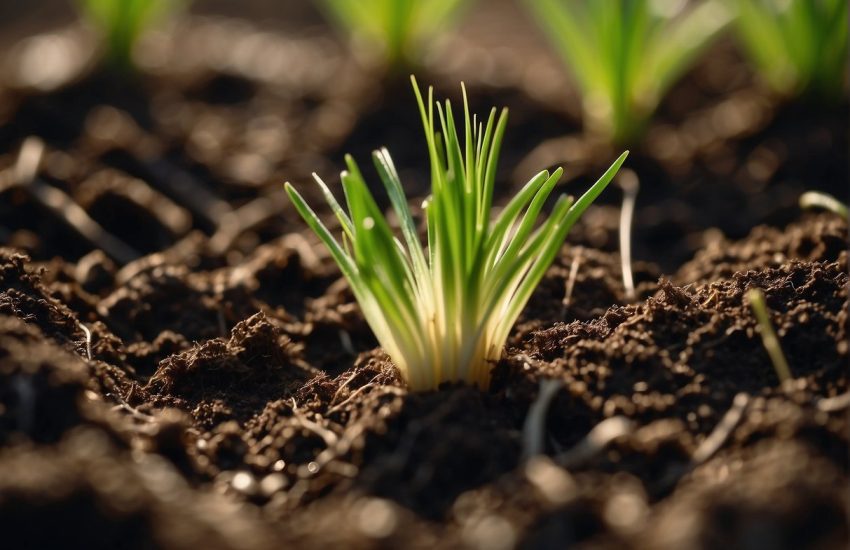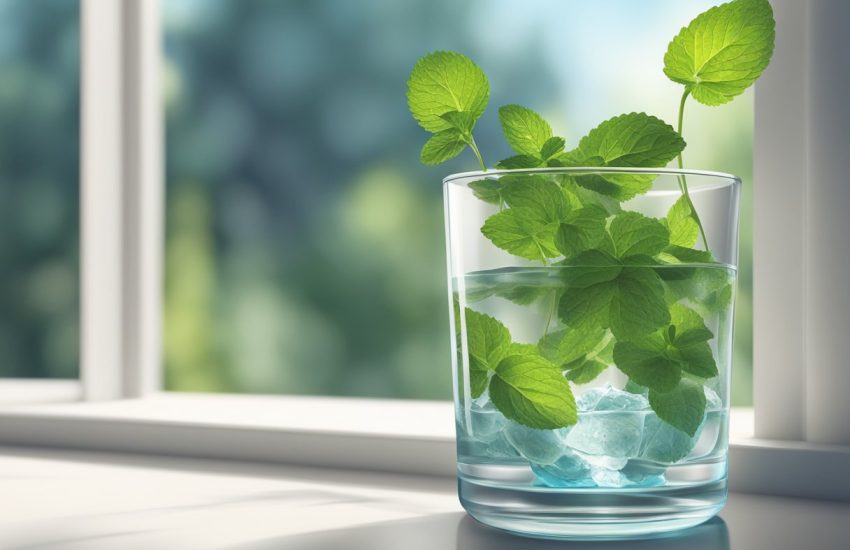Shade Loving Ground Covers Washington: Best Plants for Shady Gardens
A lot of gardeners in Washington have a tough time finding plants that actually thrive in those shady corners. Shade-loving ground covers can fill these dim spots with greenery that’s both easy to care for and good-looking.
Top ground covers for shady areas in Washington include adaptable species like pachysandra, vinca minor, and ajuga. These plants don’t mind low light or damp soil, which is pretty much the norm around here.
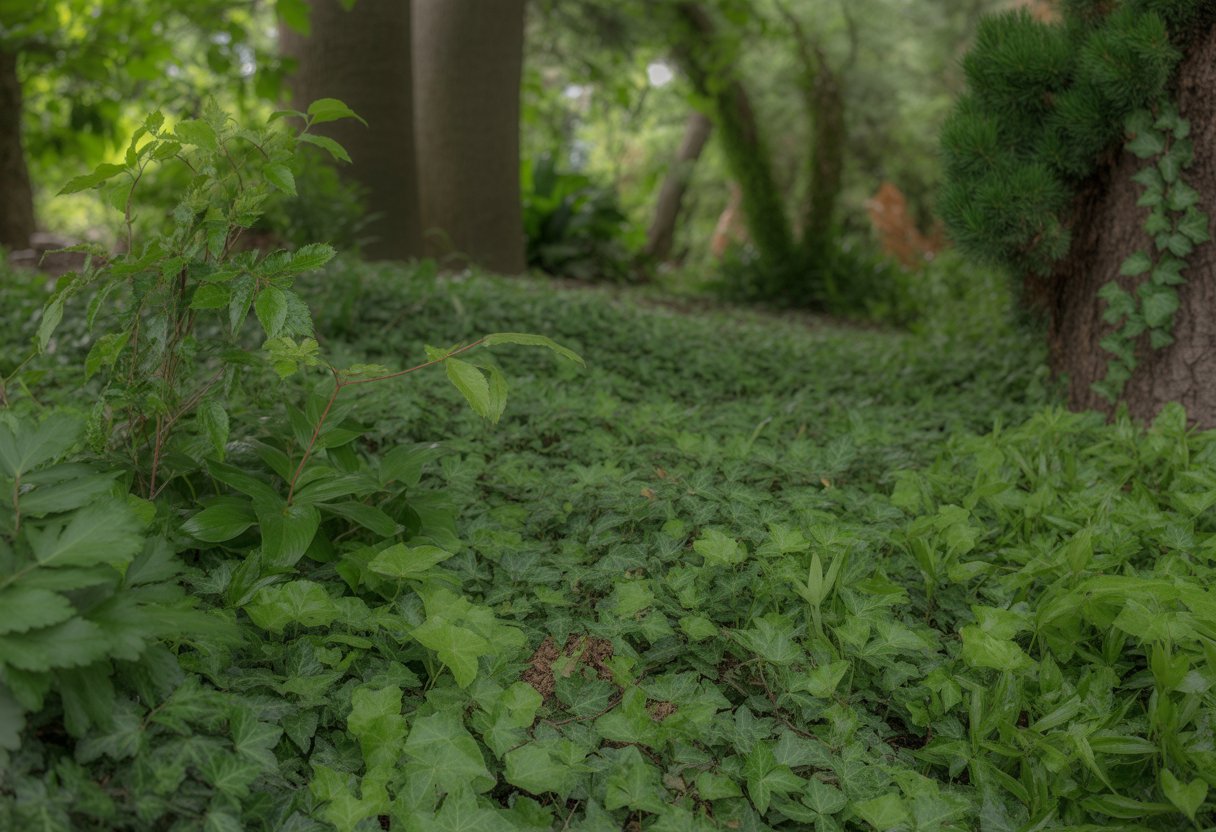
They help keep soil from washing away, choke out weeds, and add some much-needed life where grass just won’t grow. Their tough nature fits right in with Washington’s cool, wet weather, so they’re a safe bet for both homes and businesses.
Picking the right ground covers for shade means less work and a garden that stays green all year. It’s also a win for local wildlife—these plants offer shelter and food, which is always a plus.
Best Shade Loving Ground Covers for Washington

You need plants that can handle low light and the quirks of Washington’s soil and weather. That means native species, spreading plants, and anything that won’t throw a fit if it gets cold or damp.
Top Groundcover Varieties for Shade
Oxalis oregana is a native standout. It loves deep shade and moist soil, forming a thick green carpet with clover-like leaves and dainty pink flowers.
Woodland phlox brings some color to the party and spreads well even in full shade. Its little spring flowers pull in pollinators and boost the garden’s diversity.
Leptinella squalida creeps along with fine, ferny foliage, thriving in moist, shaded spots. It hugs the ground and crowds out weeds, so it works great under trees or shrubs.
Lawn Alternatives and Spreading Plants
Grass usually flops in shade, so creeping thyme or ajuga step in as reliable, green groundcovers—plus, they bloom. These plants fill in patchy lawns and don’t need much mowing or water.
Native ferns and leptinella squalida also cover ground well, even on shady slopes. They can handle a bit of foot traffic and keep the soil from washing away.
If you’re tired of grass, these spreading plants keep your soil healthy, hold moisture, and give bugs and birds a place to hang out—all with less effort.
Low Maintenance and Drought Tolerant Choices
Even though it’s usually damp in Washington, dry spells do happen. Drought-tolerant groundcovers that also like shade can save you from dragging out the hose.
Oxalis oregana doesn’t get thirsty once it’s settled in, and some phlox species are fine with dry shade and just a bit of extra water now and then.
Sedums and certain ferns check both boxes: low-maintenance and tough. The slower-spreading types mean you won’t be out there trimming all the time, which is a relief.
Notable Shade Garden Plants and Their Benefits
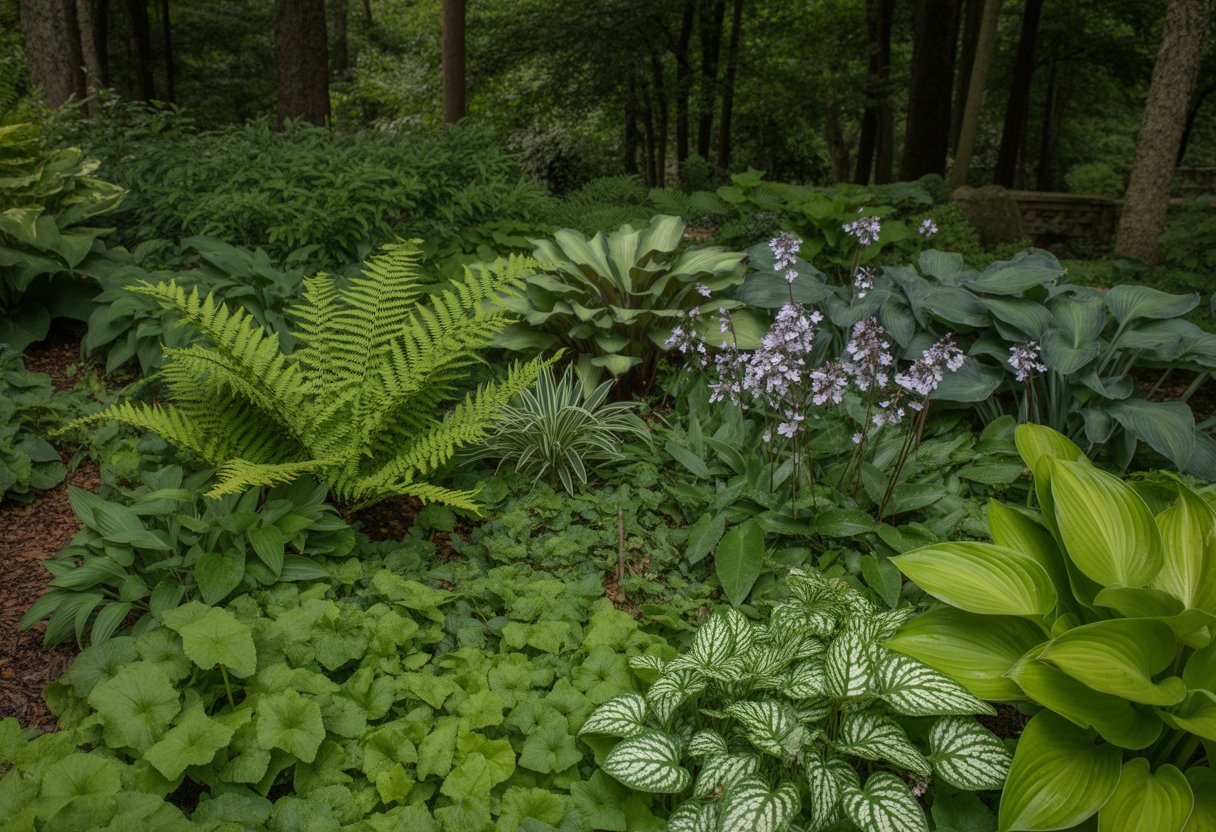
Washington’s shade-loving ground covers come in all sorts of textures and colors. They’re not just pretty—most of them boost soil health, stop erosion, and don’t need much fussing over once they’re growing.
Hostas and Hostas Varieties
Hostas are everywhere in Washington shade gardens, and for good reason. Their big, dramatic leaves come in all shades of green and blue—Sum and Substance and Blue Angel are some favorites.
They like moist, well-drained soil and don’t mind heavy shade. Hostas form dense mats that block weeds, and you can find deer-resistant types, but slugs and snails sometimes love them too.
The leaves come in all shapes and sizes, so you can use them as ground cover or as accents under shrubs.
Ferns, Pulmonaria, and Brunnera
Ferns like the Christmas fern (Polystichum acrostichoides) bring a soft, lacy look and stay green all year. Pulmonaria (lungwort) pops up with early spring flowers and spotted leaves that brighten up dark corners.
Brunnera macrophylla ‘Jack Frost’ stands out with silvery, veined leaves and tiny blue flowers. It loves cool, moist conditions and spreads into thick patches that keep the soil in place.
These plants need well-drained soil and appreciate a layer of mulch.
Epimediums, Periwinkle, and Saxifraga Stolonifera
Epimediums handle shade and dry spots under trees, with heart-shaped leaves and delicate spring flowers. Once they’re established, they don’t mind a little drought.
Periwinkle (Vinca minor) covers bare ground fast with evergreen leaves and blue-violet blooms, but it can get carried away—so keep an eye on it.
Saxifraga stolonifera (creeping saxifrage) has silver-veined leaves and small white flowers on red stems. It likes moist, shady places and spreads with runners, making it handy for uneven ground or rock gardens.
Unique and Native Options for Washington Gardens
Washington’s moist, mild climate is a dream for many shade-loving ground covers. Some of the best are native, so they fit right in and bring both beauty and a little extra help for the ecosystem.
Oxalis Oregana and Vancouveria Hexandra
Oxalis oregana is a native perennial with clover-like leaves that creates a thick green mat under trees. It prefers rich, moist soil and deep shade, and once it’s settled, it can handle dry spells. The pinkish-white flowers show up in spring for a subtle splash of color.
Vancouveria hexandra grows slowly in shady woods, forming a soft, lacy ground cover. Its light green, divided leaves and little white cup-shaped flowers in late spring give it a delicate look.
Both plants help local wildlife and don’t need much attention, so they’re perfect for more natural gardens.
Cardamine Trifolia and Wild Ginger
Cardamine trifolia hugs the ground with shiny, three-part leaves that stick around through mild winters. It forms mats in shady spots and sends up small white flowers in early spring. Humus-rich, well-drained soil is its happy place.
Wild ginger (Asarum caudatum) has broad, heart-shaped leaves that cover ground densely. It thrives in deep shade and moist conditions, spreading steadily. The brownish-purple flowers hide beneath the foliage, so you might miss them unless you look closely.
Both of these help stabilize soil and boost garden diversity while handling a range of shade levels.
Cyclamen and Pachysandra Terminalis
Cyclamen likes cool, shady spots with good drainage. Its patterned leaves and bright pink or white flowers bloom in fall or winter, depending on the type, and add much-needed color when everything else is green.
Pachysandra terminalis is a go-to evergreen with glossy leaves that make thick mats. It’s not picky about soil and loves deep shade. White flower spikes show up in early spring, but honestly, the leaves steal the show.
Both choices keep your garden looking lively all year and do a solid job at blocking weeds.
Establishing and Maintaining Shade Ground Covers
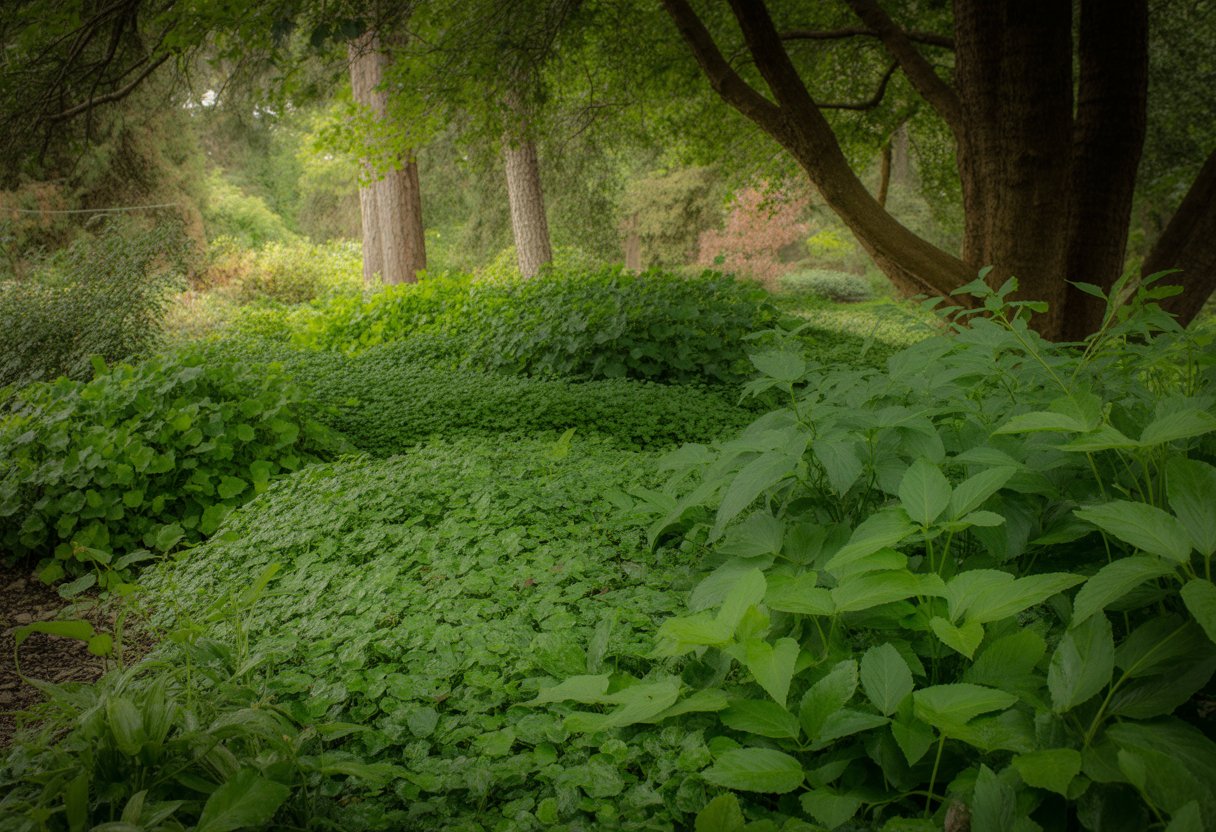
Getting shade ground covers established takes some prep—think soil, water, and keeping aggressive types in line. The right match between plant and spot makes all the difference.
Soil Preparation and Planting Techniques
Plants like ophiopogon and mondo grass like soil that drains well, leans a bit acidic, and has plenty of organic matter. Loosen the soil and mix in compost before planting to help roots settle in.
Give plants like cinquefoil and chameleon plant enough space so they don’t crowd each other. Planting in early spring or fall works best, since you’re dodging the heat.
If your soil stays soggy, try raised beds or mounded rows for better drainage. Avoid heavy clay unless you really amend it, because soggy roots just rot.
Watering and Mulching Strategies
When you’re getting ground covers started, keep the soil consistently moist—especially for creeping buttercup and english ivy. It’s better to water deeply once or twice a week than to sprinkle lightly all the time.
Spread 2-3 inches of organic mulch (shredded bark or leaf mold works) to hold in moisture and keep weeds down. Mulch also helps even out soil temperatures, which roots appreciate.
Don’t pile mulch right against plant stems or crowns, since that can cause rot. Top up the mulch once a year to keep it working.
Controlling Aggressive Spreading Plants
Some shade ground covers, like english ivy and creeping buttercup, really go wild if you let them. They’ll take over the place without much warning.
Try using physical barriers—think root barriers or even just some decent edging. That can help keep these plants from wandering where you don’t want them.
Grab your pruners and trim things back now and then. Taking off runners or stolons keeps them from muscling out your other plants.
If you want to play it safer, mix in less aggressive options like ophiopogon or mondo grass. They’ll give you coverage, but they won’t try to conquer the whole garden.

